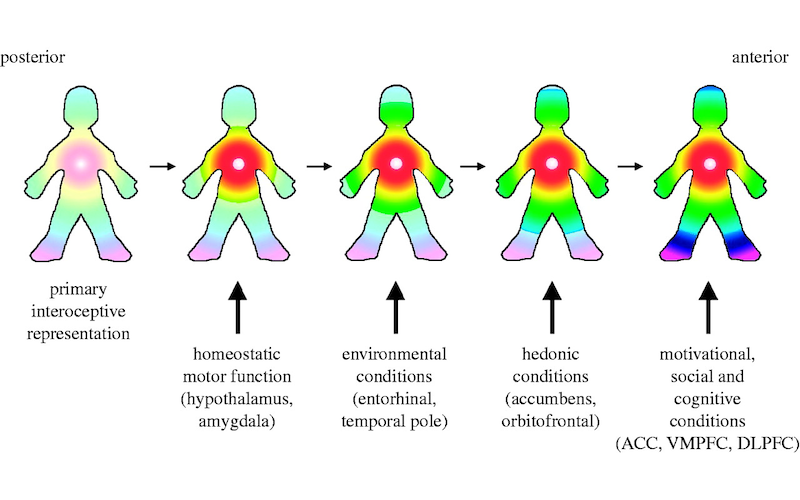
The subjective experience of time is remarkably malleable. A common effect of relaxation is time contraction. Contraction of time is the sense that less time has elapsed than the actual duration of time. When people emerge from a relaxed state, they often describe having been immersed for a short period of time when actually a longer span of ‘clock time’ has passed. By contrast the subjective sense of time dilates, the sense that more time has elapsed than the actual duration of time, in situations of heightened stress, homeostatic salience (demanding action), risk or threat. Under extreme circumstances time may even appear to stand still.
Our sense of self through time is constructed by numerous neurobiological processes. These processes have been mapped through various brain imaging and electrophysiological approaches over the last 30 years. Interestingly the neurobiological understanding of self across different time scales is remarkably similar to first person accounts from contemplatives, meditation practitioners and phenomenologists.
Through research into homeostasis, interoception and time, functional neurobiologist Bud Craig has developed the notion of the global emotional moment. The global emotional moment incorporates all homeostatic, sensory, hedonic, social, motivational and cognitive emotions and feelings. The global emotional moment is a physiological selfy that spans 100-150 milliseconds and is synchronised by endogenous alpha and theta brain waves.

The global emotional moment is displaced from the present moment by the next global emotional moment – much like a flicker book. The continuous flow of global emotional moments has been likened to a cinemascope by Bud Craig. This continuous flow consists of distinct and rapidly decaying past moments. Before decaying, these historical moments accumulate and form a transient substrate. This accumulation enables the neurobiological comparison of successive moments. This process is critical to our perception of the material self through time and informs homeostasis.

In phenomenology this transient accumulation of moments is referred to as the specious present. Bud Craig’s cinemascope brings to mind Husserl’s phenomenological conception of time consciousness and the specious present.

Although the neurobiological mechanisms of time perception are now quite well mapped out it was not until recently that the influence of systemic physiological processes on neurobiological time perception have been teased out. Current research indicates that endogenous oscillations inform the neurobiological construction and subjective experience of time. This process is particularly sensitive to the oscillations and dynamics of the cardiovascular system. This means that the rhythmic oscillations within the organism influence our experience of time.
Vascular distention and blood flow generate time-coded cardiovascular information that is processed in the interoceptive cortex. This information incorporates heart rate variability and is combined with other interoceptive streams (related to metabolism, temperature, pain etc) in the core control network. This time-coded representation of the material self directly informs the action of the autonomic nervous system. Bud Craig describes this arrangement as enabling ‘the homeostatic motor system to sense the effect of its own actions in the living body at high resolution in real time.’
This interoceptive information is continuously shared with other brain networks that are involved in regulating feelings, motivation and emotional states which influence the overall state of the organism. The quality of this overall state is what Varela refers to as affective tonality.
Affective tonality is influenced by numerous neurophysiological systems and processes – most notably interoception. Fluctuations or perturbations are the currency of self-organising systems. Organisms are propelled from one moment of salience to the next through irresistibly persistent cycles that are consistently informed by affective tonality. Every ensuing moment is shaped by previous moments.
FEATURED IMAGE:
A.D. (Bud) Craig. Emotional moments across time: a possible neural basis for time perception in the anterior insula (2009).
